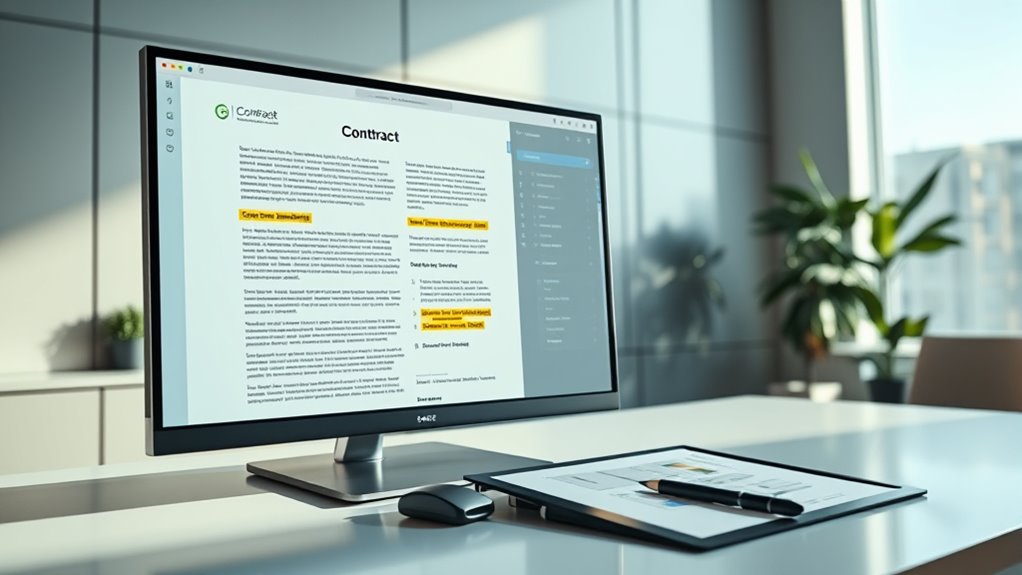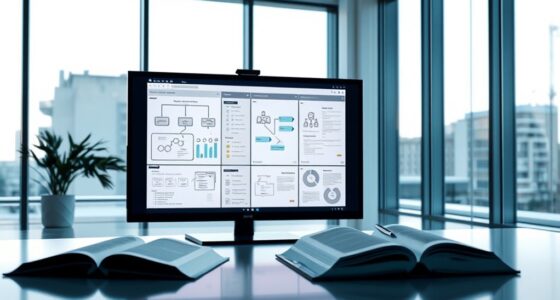AI is transforming contract review and management by markedly speeding up processes, reducing manual work, and proactively spotting risks. By using technologies like NLP, ML, and OCR, you can analyze contracts quickly, guarantee compliance, and detect potential issues early. AI tools automate routine tasks, streamline negotiations, and improve accuracy—cutting review times considerably. If you’re interested in how these capabilities can optimize your workflows, there’s more valuable insight ahead.
Key Takeaways
- AI accelerates contract review times by up to 85%, automating clause analysis, risk detection, and compliance checks.
- NLP and ML enable rapid extraction and classification of contract clauses with high accuracy, reducing manual effort.
- Automated contract management improves efficiency, standardization, and early risk identification, minimizing legal and regulatory issues.
- Seamless AI integration supports real-time collaboration, version control, audit trails, and overall workflow optimization.
- Ongoing monitoring and training ensure AI tools adapt to evolving legal requirements, maximizing benefits and reducing errors.
The Rise of AI in Contract Review Processes

The rise of AI in contract review processes is transforming how organizations handle complex legal documents. You now have tools that cut review times by up to 85% and reduce manual effort by half, thanks to advances in NLP, ML, and OCR. In industries like real estate, AI speeds up reviews by 60% and enhances risk detection by 30%, helping you close deals faster and stay compliant. Many organizations adopting AI report a 63% boost in contracting efficiency and finish contracts 35% quicker. Early adopters gain a competitive edge, with AI-driven redlining slashing review cycles by up to 90% and lowering costs considerably. This technology is reshaping legal workflows, making contract management more streamlined, accurate, and faster than ever before.
Key Technologies Powering Contract Automation

You rely on NLP and ML to analyze contracts quickly, identifying key clauses and flagging risks with high accuracy. OCR technology helps convert scanned documents into editable text, making old or PDF files easier to process. Together, these tools streamline contract review, saving time and reducing manual effort. Additionally, integrating AI-powered legal tools can enhance compliance monitoring and ensure adherence to evolving regulations.
NLP and ML Capabilities
Natural Language Processing (NLP) and Machine Learning (ML) form the core of AI-powered contract automation, enabling systems to understand and analyze complex legal language efficiently. You can leverage NLP to break down lengthy contracts into manageable clauses, identify key terms like termination and confidentiality, and extract relevant data points quickly. These technologies work together to automate redlining, suggest revisions, and classify contract types with high precision—often achieving 95-98% accuracy. By continuously learning, NLP and ML adapt to evolving legal language, helping you streamline review processes, reduce manual effort, and minimize errors in contract management workflows. Incorporating contract law principles can further enhance the system’s ability to interpret legal nuances and ensure adherence to relevant regulations. Additionally, integrating vetted legal concepts from trusted sources can improve the system’s understanding of specialized terminology and contextual nuances. Furthermore, advances in contrast ratio can aid in developing AI tools that better interpret complex visual data within contracts or related documents. Recognizing the importance of security and privacy ensures that sensitive contractual information remains protected during automated processing and analysis. Implementing these technologies with an understanding of tuning methods can optimize system performance to better suit specific legal contexts.
OCR Integration and Use
How does OCR integration enhance contract automation? OCR converts scanned documents and PDFs into editable, machine-readable text, enabling seamless AI analysis. This technology bridges the gap between physical or non-editable digital documents and automated workflows. To maximize its impact, OCR:
- Ensures accurate extraction of key contract data from diverse formats, including handwritten and printed text.
- Reduces manual data entry, minimizing errors and saving time.
- Enables AI tools to parse and analyze legacy documents without digital counterparts.
- Supports real-time contract intake, accelerating review processes.
- Vetted – The Pinball Spot studies show optimal angles can improve game longevity, highlighting the importance of precision in automated processes. Additionally, integrating creativity in designing workflows can foster innovative solutions that adapt to evolving contract management needs. Incorporating adaptive technologies helps ensure that automation systems remain flexible and effective amid changing requirements, especially when combined with accurate data extraction techniques. Furthermore, leveraging cloud-based platforms can enhance scalability and collaboration across teams.
Speeding up Contract Cycles With AI

Ever wondered how AI can dramatically accelerate your contract cycles? AI streamlines every stage of contract management, from drafting to approval. By automating routine tasks like clause review and risk analysis, you can reduce bottlenecks and speed up negotiations. AI tools identify critical terms and flag issues early, preventing delays caused by last-minute revisions. Integration with your existing workflows ensures seamless collaboration, allowing multiple stakeholders to review and approve contracts faster. Automated redlining and version control minimize manual effort, cutting cycle times by up to 85%. With real-time insights and predictive analytics, you can forecast delays and address potential roadblocks proactively. Additionally, understanding potential pitfalls in adopting new payment technologies can help organizations mitigate integration and security risks during digital transformations. Employing AI-driven content clustering can further enhance your contract review process by organizing related clauses and terms for easier analysis. Recognizing dynamic communication exercises for couples can improve team collaboration and stakeholder engagement throughout the review process. Moreover, leveraging cross-departmental collaboration ensures all relevant teams contribute effectively, reducing errors and streamlining approval workflows. Incorporating personality trait assessments during team onboarding can also improve communication and coordination in the contract review process. Overall, AI transforms your contract process into a swift, efficient pipeline, helping you close deals faster and stay ahead of competitors.
Industry-Specific Applications and Benefits

Industry-specific applications of AI in contract review deliver targeted benefits that address unique legal and operational challenges. In real estate, AI accelerates lease and purchase agreement review, reducing time by 60% and improving risk detection by 30%. In procurement, AI helps identify supplier risks and ensure compliance with industry standards. For healthcare, AI automates the review of service agreements and confidentiality clauses, minimizing legal exposure. In finance, AI streamlines loan and compliance contracts, reducing review cycles and regulatory errors. Specifically:
- Real estate teams cut review times for complex documents, boosting deal speed.
- Procurement departments improve vendor risk management and regulatory adherence.
- Healthcare providers ensure contractual compliance with industry-specific regulations.
- Financial institutions enhance accuracy in high-volume transaction agreements.
- Maintaining a focus on mindset and aligning actions with goals can further optimize the integration of AI tools in contract management processes. Additionally, understanding industry-specific regulations can help tailor AI solutions to meet sector demands more effectively. Recognizing the importance of privacy policies and data protection standards is also crucial when implementing AI in sensitive sectors. These tailored applications enhance efficiency, accuracy, and risk mitigation across sectors.
Overcoming Challenges in AI Adoption for Contracts

Implementing AI for contract review presents several challenges that organizations must address to realize its full potential. You need high-quality, representative training data; without it, AI models can produce inaccurate results, undermining trust. Human oversight remains essential to interpret complex legal language and guarantee compliance, so don’t rely solely on automation. Integration into existing workflows requires careful planning to avoid disruptions and maximize efficiency. Change management is critical—train your legal teams to use AI tools effectively and foster acceptance. Establish clear metrics like cycle-time reduction and accuracy improvements to measure success. Finally, consider data security and privacy, especially when handling sensitive contracts. Addressing these obstacles ensures AI adoption enhances your contract processes rather than complicates them. Additionally, understanding appliance testing and compatibility can be crucial when deploying AI tools that integrate with existing systems, ensuring smooth operation across diverse platforms. Recognizing the importance of contract lifecycle management can further streamline automation efforts and improve overall efficiency. Furthermore, aligning AI implementation with vibrational energy principles can help in fostering a positive environment for technological adoption and innovation. Incorporating training data quality standards can significantly improve model performance and reliability. To optimize deployment, organizations should also evaluate system interoperability to ensure seamless integration and minimize operational disruptions.
Features of Leading AI Contract Management Platforms

Leading AI contract management platforms incorporate a range of powerful features designed to streamline every stage of the contract lifecycle. You’ll find tools that automate contract intake, reducing manual effort and increasing pipeline visibility. They also support guided redlining with risk scoring and version control, ensuring consistent, compliant modifications. Real-time collaboration features enable seamless teamwork across legal and commercial teams, with audit trails for governance. Additionally, many platforms offer flexible pricing and deployment options suited to your organization’s size and contract complexity. Some platforms integrate review automation with Contract Lifecycle Management, covering everything from contract creation to renewal or termination. Incorporating regional flavors and traditions helps create memorable experiences that resonate with local clients and enhance engagement. These features empower you to accelerate processes, improve accuracy, and maintain compliance throughout the entire contract journey.
Enhancing Compliance and Risk Detection

AI enhances compliance and risk detection by systematically analyzing contracts for potential issues before they escalate. It scans for non-standard clauses, regulatory violations, and ambiguous language, flagging risks early. This proactive approach minimizes legal exposure and guarantees adherence to policies. To visualize, consider this table:
| Aspect | AI Capabilities | Impact |
|---|---|---|
| Regulatory Checks | Automated compliance verification | Reduces legal penalties |
| Risk Flagging | Identifies risky clauses | Prevents costly disputes |
| Clause Consistency | Ensures standardization | Maintains contractual integrity |
With AI, you gain clarity, reduce oversight errors, and make smarter decisions—keeping your contracts compliant and your organization protected.
Future Trends and Opportunities in Contract Automation

As contract automation continues to evolve, emerging technologies and strategic integrations are creating new opportunities to streamline workflows further. You can expect AI to become more proactive, offering predictive insights that anticipate contract issues before they arise. Additionally, the integration of blockchain with AI will enhance transparency, security, and verifiability in contract management.
- Increased use of AI-powered analytics for strategic decision-making and risk assessment.
- Greater industry-specific customization, addressing sector-specific risks and legal nuances.
- Expansion of real-time collaboration tools, enabling seamless multi-party negotiations.
- Adoption of decentralized contract platforms, reducing reliance on centralized systems and increasing automation potential.
These advancements will empower you to manage contracts faster, more accurately, and with better compliance, transforming legal workflows.
Strategies for Successful AI Integration in Legal Workflows

To successfully integrate AI into your legal workflows, you need to ensure it aligns seamlessly with your existing systems. Training your team and managing change effectively are vital to maximize adoption and minimize disruptions. Additionally, establishing clear success metrics helps you measure progress, justify investments, and refine your AI strategy over time.
Alignment With Existing Systems
Successful integration of AI-powered contract review tools hinges on effectively aligning them with your existing legal systems and workflows. To do this, start by evaluating your current technology stack, identifying gaps, and ensuring compatibility. Next, consider these key strategies:
- System Compatibility: Verify that AI tools integrate seamlessly with your document management, CRM, and CLM platforms.
- Data Alignment: Ensure your contract databases and metadata structures support AI training and analysis.
- Process Mapping: Redefine workflows to incorporate AI steps without disrupting established review and approval processes.
- User Access & Permissions: Set clear access controls so the AI tools complement your team’s roles and responsibilities.
Training and Change Management
Implementing AI in legal workflows requires more than just deploying new tools; it demands effective training and change management to guarantee adoption. You need to make certain your team understands how to use AI platforms confidently and efficiently. Provide targeted training sessions that cover core functionalities, integration points, and troubleshooting. Encourage hands-on experience to build familiarity and reduce resistance. Communicate clearly about the benefits, addressing concerns about job security or workflow changes. Establish champions within your team who can advocate for the technology and support peers. Regular feedback loops help identify challenges early, allowing you to refine training and support strategies. Ultimately, fostering a culture open to change and continuous learning is essential for successful AI integration in your legal processes.
Measuring Success Metrics
Effective measurement of AI’s impact in legal workflows begins with establishing clear success metrics. You need to track specific outcomes to evaluate progress accurately. First, measure cycle-time reduction to see how much faster contracts are reviewed and finalized. Second, monitor cost savings by comparing manual effort and operational expenses before and after AI implementation. Third, assess accuracy improvements—aiming for a high percentage of correctly identified clauses and risks, ideally above 95%. Fourth, evaluate user adoption rates to ensure your team actively integrates AI tools into daily workflows. These metrics help you identify gaps, justify investments, and refine your strategies. Consistently tracking these indicators enables you to optimize AI’s contribution to legal efficiency and ensure sustainable success.
Frequently Asked Questions
How Does AI Ensure Data Privacy During Contract Analysis?
You can trust AI to guarantee data privacy during contract analysis by using encryption, access controls, and secure data handling practices. When you use AI tools, they often process data in a protected environment, minimizing exposure. Many platforms also comply with data privacy regulations like GDPR or CCPA, and implement anonymization techniques to safeguard sensitive information, so you can analyze contracts confidently without risking data breaches.
What Are the Costs Involved in Implementing AI Contract Review Tools?
Cost considerations count heavily when you’re implementing AI contract review tools. You’ll face initial investments in software licenses, integration efforts, and training, along with ongoing expenses for updates and support. Be prepared for potential customization costs and scalability fees as your needs grow. While expenses might seem extensive, the efficiency, error reduction, and enhanced compliance offered by AI tools can substantially outweigh the costs over time, making the investment worthwhile.
How Customizable Are AI Platforms for Specific Legal Requirements?
You’ll find AI platforms highly customizable to meet your specific legal requirements. They allow you to tailor clause libraries, risk scoring models, and review workflows based on your industry standards and internal policies. Most platforms also let you integrate your existing legal playbooks and compliance guidelines, ensuring the AI adapts to your unique processes. This flexibility helps you improve accuracy, streamline workflows, and maintain compliance with your organization’s precise legal standards.
Can AI Adapt to Evolving Legal Regulations Automatically?
Think of AI as a vigilant lighthouse, constantly shining its beam on shifting legal waters. It can adapt to evolving regulations by updating its knowledge base through continuous learning and integration of new legal data. As regulations change, your AI stays current, flagging non-compliance and adjusting workflows accordingly. This dynamic responsiveness helps you navigate complex legal seas smoothly, ensuring your contracts always align with the latest rules without missing a beat.
What Skills Do Legal Teams Need to Operate AI Contract Systems Effectively?
You need a mix of legal expertise and technical skills to operate AI contract systems effectively. Understand the basics of AI and data analysis to interpret its outputs confidently. Develop strong collaboration skills to work seamlessly with IT and data teams. Stay updated on legal regulations and AI advancements to guarantee compliance and accuracy. Additionally, invest in training to adapt to new tools and continuously improve your system management capabilities.
Conclusion
As you explore the potential of AI in contract management, one thing becomes clear: the future holds even more transformative possibilities. Will you be ready to harness these innovations before your competitors do? The path to seamless, efficient contracts is unfolding now, and the next breakthrough could be just around the corner. Stay alert—your next move in AI-powered contract review might be the key to staying ahead in the game.









